University Assignment: Reflective Report on Teamwork & Leadership
VerifiedAdded on 2022/10/17
|10
|2558
|14
Report
AI Summary
This reflective report explores the concepts of teamwork and leadership, examining the role of a leader in an organization, leadership styles, and team-building theories. The report begins with an introduction to team building, its complexities, and the importance of leadership in achieving organizational goals. It delves into the qualities of an effective manager, including communication and motivation skills, and discusses different leadership styles such as laissez-faire, authoritarian, participatory, transactional, and transformational leadership. The author reflects on their own experiences as a team leader, identifying strengths and weaknesses and evaluating how their views on leadership have evolved. The report includes a case study involving challenges faced in a marketing and sales company, analyzing problems and solutions related to team management. The author also emphasizes the importance of communication and strategic thinking for effective team building and concludes with a summary of the key learnings and implications for future leadership development, particularly in the context of a marketing and sales environment. The assignment is a reflective journal entry that shares learning in relation to the concepts, theories and practices of the subject.
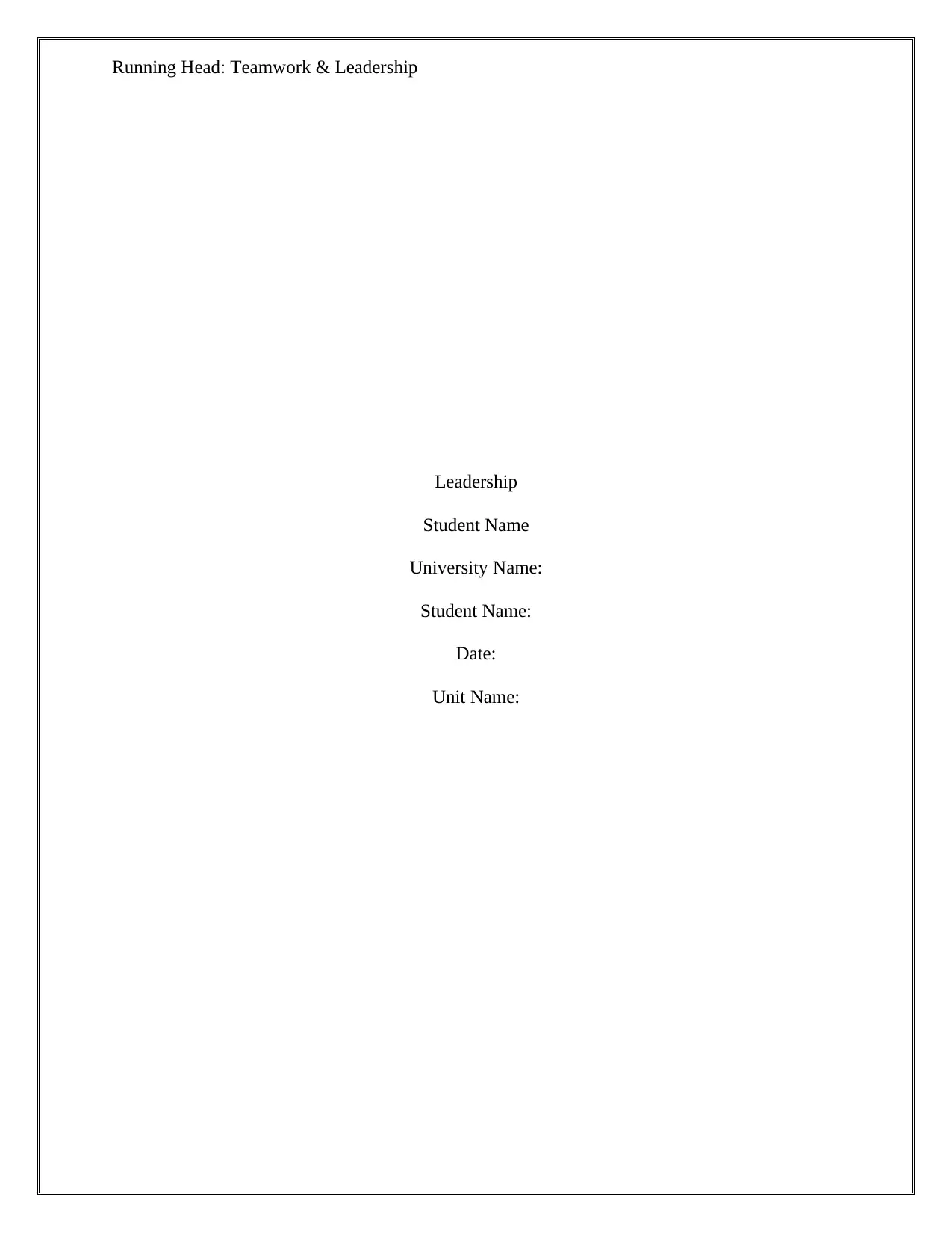
Running Head: Teamwork & Leadership
Leadership
Student Name
University Name:
Student Name:
Date:
Unit Name:
Leadership
Student Name
University Name:
Student Name:
Date:
Unit Name:
Paraphrase This Document
Need a fresh take? Get an instant paraphrase of this document with our AI Paraphraser
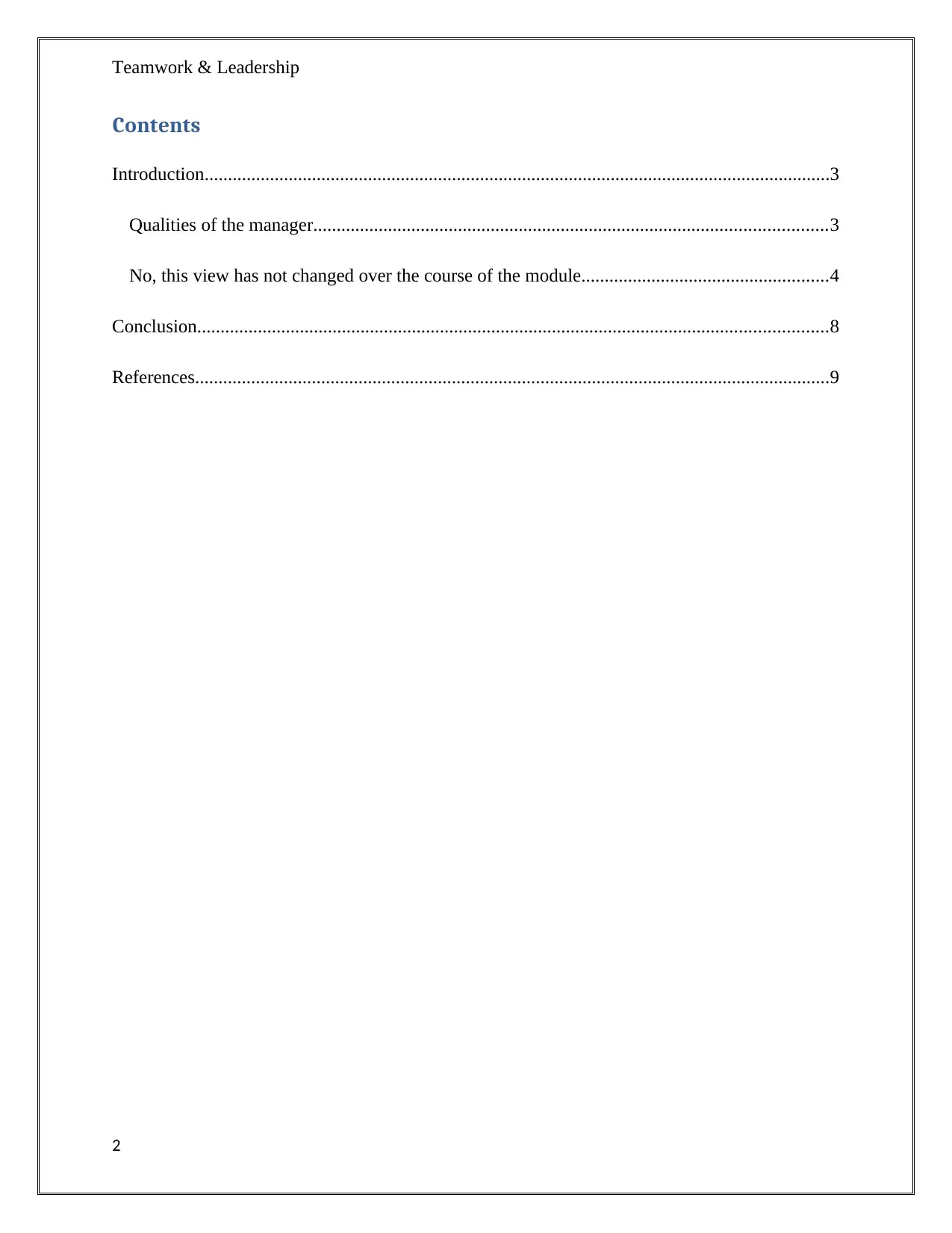
Teamwork & Leadership
Contents
Introduction......................................................................................................................................3
Qualities of the manager..............................................................................................................3
No, this view has not changed over the course of the module.....................................................4
Conclusion.......................................................................................................................................8
References........................................................................................................................................9
2
Contents
Introduction......................................................................................................................................3
Qualities of the manager..............................................................................................................3
No, this view has not changed over the course of the module.....................................................4
Conclusion.......................................................................................................................................8
References........................................................................................................................................9
2
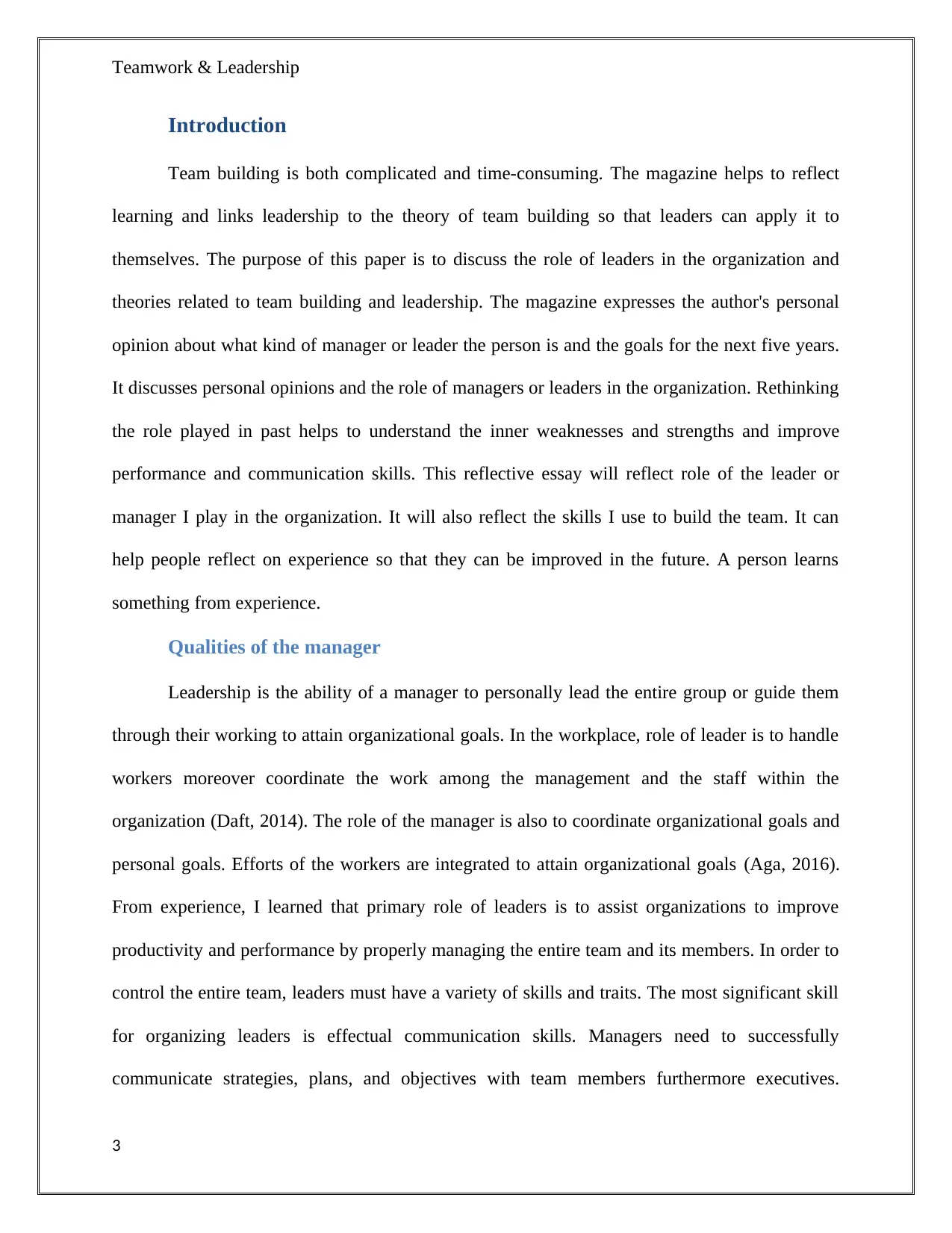
Teamwork & Leadership
Introduction
Team building is both complicated and time-consuming. The magazine helps to reflect
learning and links leadership to the theory of team building so that leaders can apply it to
themselves. The purpose of this paper is to discuss the role of leaders in the organization and
theories related to team building and leadership. The magazine expresses the author's personal
opinion about what kind of manager or leader the person is and the goals for the next five years.
It discusses personal opinions and the role of managers or leaders in the organization. Rethinking
the role played in past helps to understand the inner weaknesses and strengths and improve
performance and communication skills. This reflective essay will reflect role of the leader or
manager I play in the organization. It will also reflect the skills I use to build the team. It can
help people reflect on experience so that they can be improved in the future. A person learns
something from experience.
Qualities of the manager
Leadership is the ability of a manager to personally lead the entire group or guide them
through their working to attain organizational goals. In the workplace, role of leader is to handle
workers moreover coordinate the work among the management and the staff within the
organization (Daft, 2014). The role of the manager is also to coordinate organizational goals and
personal goals. Efforts of the workers are integrated to attain organizational goals (Aga, 2016).
From experience, I learned that primary role of leaders is to assist organizations to improve
productivity and performance by properly managing the entire team and its members. In order to
control the entire team, leaders must have a variety of skills and traits. The most significant skill
for organizing leaders is effectual communication skills. Managers need to successfully
communicate strategies, plans, and objectives with team members furthermore executives.
3
Introduction
Team building is both complicated and time-consuming. The magazine helps to reflect
learning and links leadership to the theory of team building so that leaders can apply it to
themselves. The purpose of this paper is to discuss the role of leaders in the organization and
theories related to team building and leadership. The magazine expresses the author's personal
opinion about what kind of manager or leader the person is and the goals for the next five years.
It discusses personal opinions and the role of managers or leaders in the organization. Rethinking
the role played in past helps to understand the inner weaknesses and strengths and improve
performance and communication skills. This reflective essay will reflect role of the leader or
manager I play in the organization. It will also reflect the skills I use to build the team. It can
help people reflect on experience so that they can be improved in the future. A person learns
something from experience.
Qualities of the manager
Leadership is the ability of a manager to personally lead the entire group or guide them
through their working to attain organizational goals. In the workplace, role of leader is to handle
workers moreover coordinate the work among the management and the staff within the
organization (Daft, 2014). The role of the manager is also to coordinate organizational goals and
personal goals. Efforts of the workers are integrated to attain organizational goals (Aga, 2016).
From experience, I learned that primary role of leaders is to assist organizations to improve
productivity and performance by properly managing the entire team and its members. In order to
control the entire team, leaders must have a variety of skills and traits. The most significant skill
for organizing leaders is effectual communication skills. Managers need to successfully
communicate strategies, plans, and objectives with team members furthermore executives.
3
⊘ This is a preview!⊘
Do you want full access?
Subscribe today to unlock all pages.

Trusted by 1+ million students worldwide
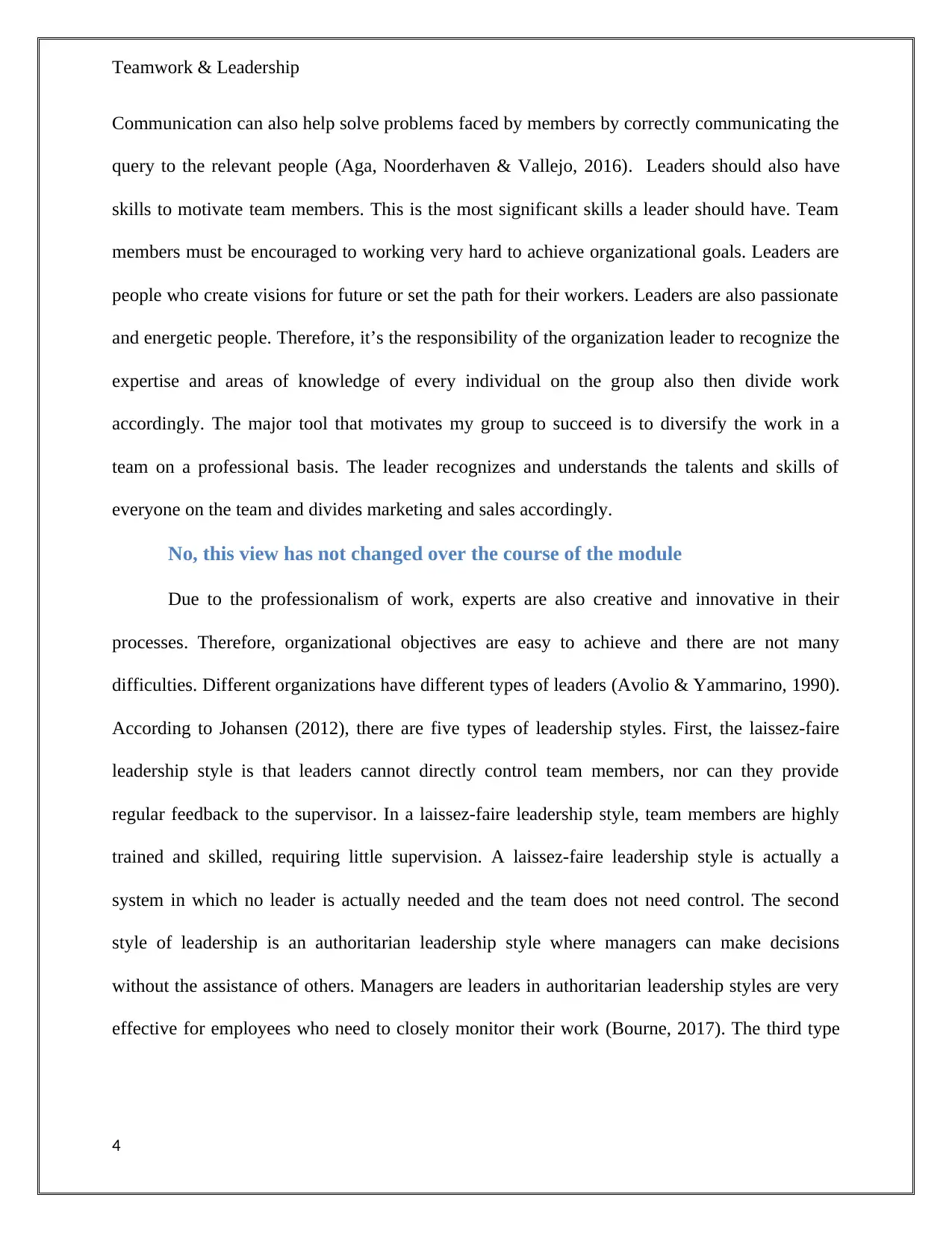
Teamwork & Leadership
Communication can also help solve problems faced by members by correctly communicating the
query to the relevant people (Aga, Noorderhaven & Vallejo, 2016). Leaders should also have
skills to motivate team members. This is the most significant skills a leader should have. Team
members must be encouraged to working very hard to achieve organizational goals. Leaders are
people who create visions for future or set the path for their workers. Leaders are also passionate
and energetic people. Therefore, it’s the responsibility of the organization leader to recognize the
expertise and areas of knowledge of every individual on the group also then divide work
accordingly. The major tool that motivates my group to succeed is to diversify the work in a
team on a professional basis. The leader recognizes and understands the talents and skills of
everyone on the team and divides marketing and sales accordingly.
No, this view has not changed over the course of the module
Due to the professionalism of work, experts are also creative and innovative in their
processes. Therefore, organizational objectives are easy to achieve and there are not many
difficulties. Different organizations have different types of leaders (Avolio & Yammarino, 1990).
According to Johansen (2012), there are five types of leadership styles. First, the laissez-faire
leadership style is that leaders cannot directly control team members, nor can they provide
regular feedback to the supervisor. In a laissez-faire leadership style, team members are highly
trained and skilled, requiring little supervision. A laissez-faire leadership style is actually a
system in which no leader is actually needed and the team does not need control. The second
style of leadership is an authoritarian leadership style where managers can make decisions
without the assistance of others. Managers are leaders in authoritarian leadership styles are very
effective for employees who need to closely monitor their work (Bourne, 2017). The third type
4
Communication can also help solve problems faced by members by correctly communicating the
query to the relevant people (Aga, Noorderhaven & Vallejo, 2016). Leaders should also have
skills to motivate team members. This is the most significant skills a leader should have. Team
members must be encouraged to working very hard to achieve organizational goals. Leaders are
people who create visions for future or set the path for their workers. Leaders are also passionate
and energetic people. Therefore, it’s the responsibility of the organization leader to recognize the
expertise and areas of knowledge of every individual on the group also then divide work
accordingly. The major tool that motivates my group to succeed is to diversify the work in a
team on a professional basis. The leader recognizes and understands the talents and skills of
everyone on the team and divides marketing and sales accordingly.
No, this view has not changed over the course of the module
Due to the professionalism of work, experts are also creative and innovative in their
processes. Therefore, organizational objectives are easy to achieve and there are not many
difficulties. Different organizations have different types of leaders (Avolio & Yammarino, 1990).
According to Johansen (2012), there are five types of leadership styles. First, the laissez-faire
leadership style is that leaders cannot directly control team members, nor can they provide
regular feedback to the supervisor. In a laissez-faire leadership style, team members are highly
trained and skilled, requiring little supervision. A laissez-faire leadership style is actually a
system in which no leader is actually needed and the team does not need control. The second
style of leadership is an authoritarian leadership style where managers can make decisions
without the assistance of others. Managers are leaders in authoritarian leadership styles are very
effective for employees who need to closely monitor their work (Bourne, 2017). The third type
4
Paraphrase This Document
Need a fresh take? Get an instant paraphrase of this document with our AI Paraphraser
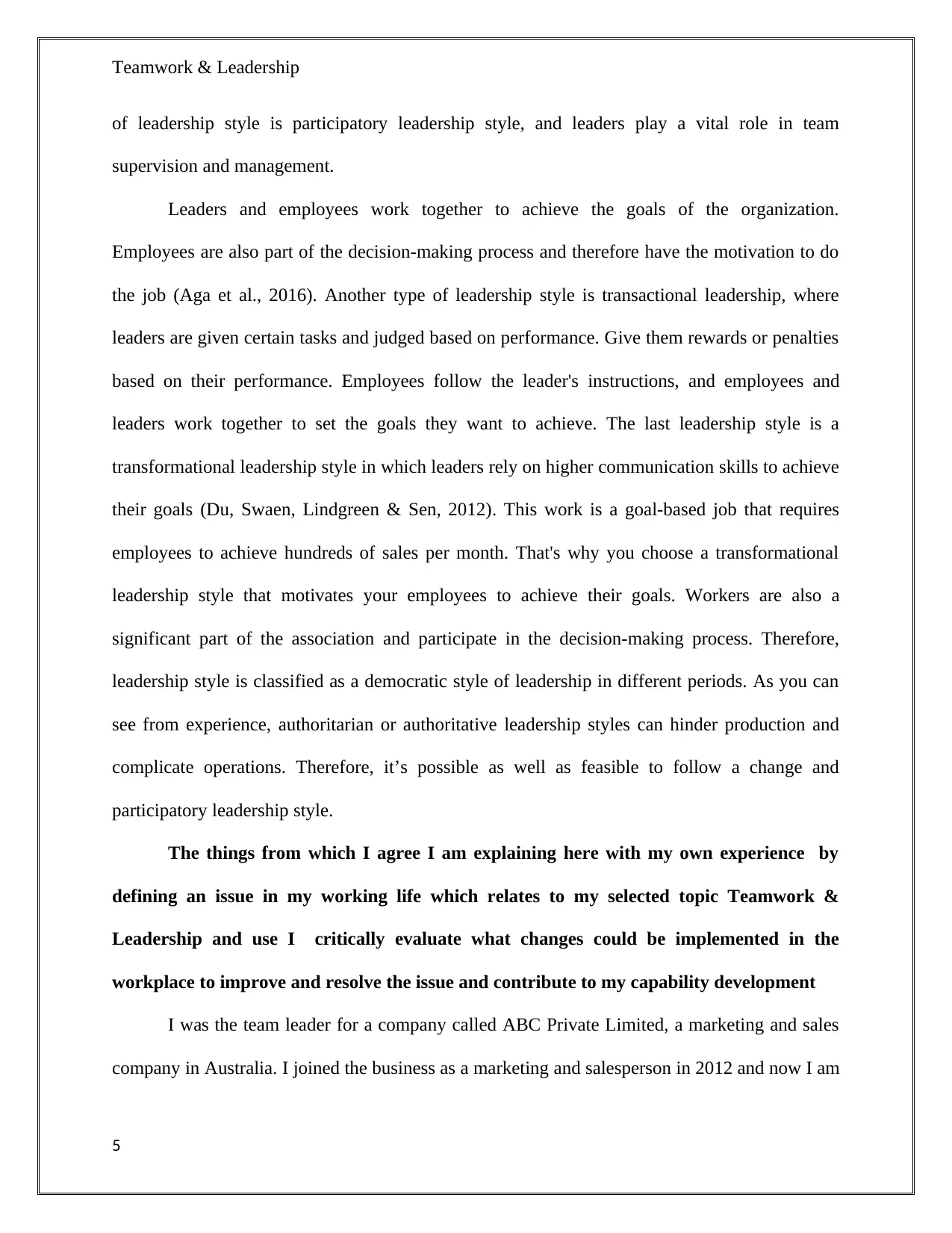
Teamwork & Leadership
of leadership style is participatory leadership style, and leaders play a vital role in team
supervision and management.
Leaders and employees work together to achieve the goals of the organization.
Employees are also part of the decision-making process and therefore have the motivation to do
the job (Aga et al., 2016). Another type of leadership style is transactional leadership, where
leaders are given certain tasks and judged based on performance. Give them rewards or penalties
based on their performance. Employees follow the leader's instructions, and employees and
leaders work together to set the goals they want to achieve. The last leadership style is a
transformational leadership style in which leaders rely on higher communication skills to achieve
their goals (Du, Swaen, Lindgreen & Sen, 2012). This work is a goal-based job that requires
employees to achieve hundreds of sales per month. That's why you choose a transformational
leadership style that motivates your employees to achieve their goals. Workers are also a
significant part of the association and participate in the decision-making process. Therefore,
leadership style is classified as a democratic style of leadership in different periods. As you can
see from experience, authoritarian or authoritative leadership styles can hinder production and
complicate operations. Therefore, it’s possible as well as feasible to follow a change and
participatory leadership style.
The things from which I agree I am explaining here with my own experience by
defining an issue in my working life which relates to my selected topic Teamwork &
Leadership and use I critically evaluate what changes could be implemented in the
workplace to improve and resolve the issue and contribute to my capability development
I was the team leader for a company called ABC Private Limited, a marketing and sales
company in Australia. I joined the business as a marketing and salesperson in 2012 and now I am
5
of leadership style is participatory leadership style, and leaders play a vital role in team
supervision and management.
Leaders and employees work together to achieve the goals of the organization.
Employees are also part of the decision-making process and therefore have the motivation to do
the job (Aga et al., 2016). Another type of leadership style is transactional leadership, where
leaders are given certain tasks and judged based on performance. Give them rewards or penalties
based on their performance. Employees follow the leader's instructions, and employees and
leaders work together to set the goals they want to achieve. The last leadership style is a
transformational leadership style in which leaders rely on higher communication skills to achieve
their goals (Du, Swaen, Lindgreen & Sen, 2012). This work is a goal-based job that requires
employees to achieve hundreds of sales per month. That's why you choose a transformational
leadership style that motivates your employees to achieve their goals. Workers are also a
significant part of the association and participate in the decision-making process. Therefore,
leadership style is classified as a democratic style of leadership in different periods. As you can
see from experience, authoritarian or authoritative leadership styles can hinder production and
complicate operations. Therefore, it’s possible as well as feasible to follow a change and
participatory leadership style.
The things from which I agree I am explaining here with my own experience by
defining an issue in my working life which relates to my selected topic Teamwork &
Leadership and use I critically evaluate what changes could be implemented in the
workplace to improve and resolve the issue and contribute to my capability development
I was the team leader for a company called ABC Private Limited, a marketing and sales
company in Australia. I joined the business as a marketing and salesperson in 2012 and now I am
5
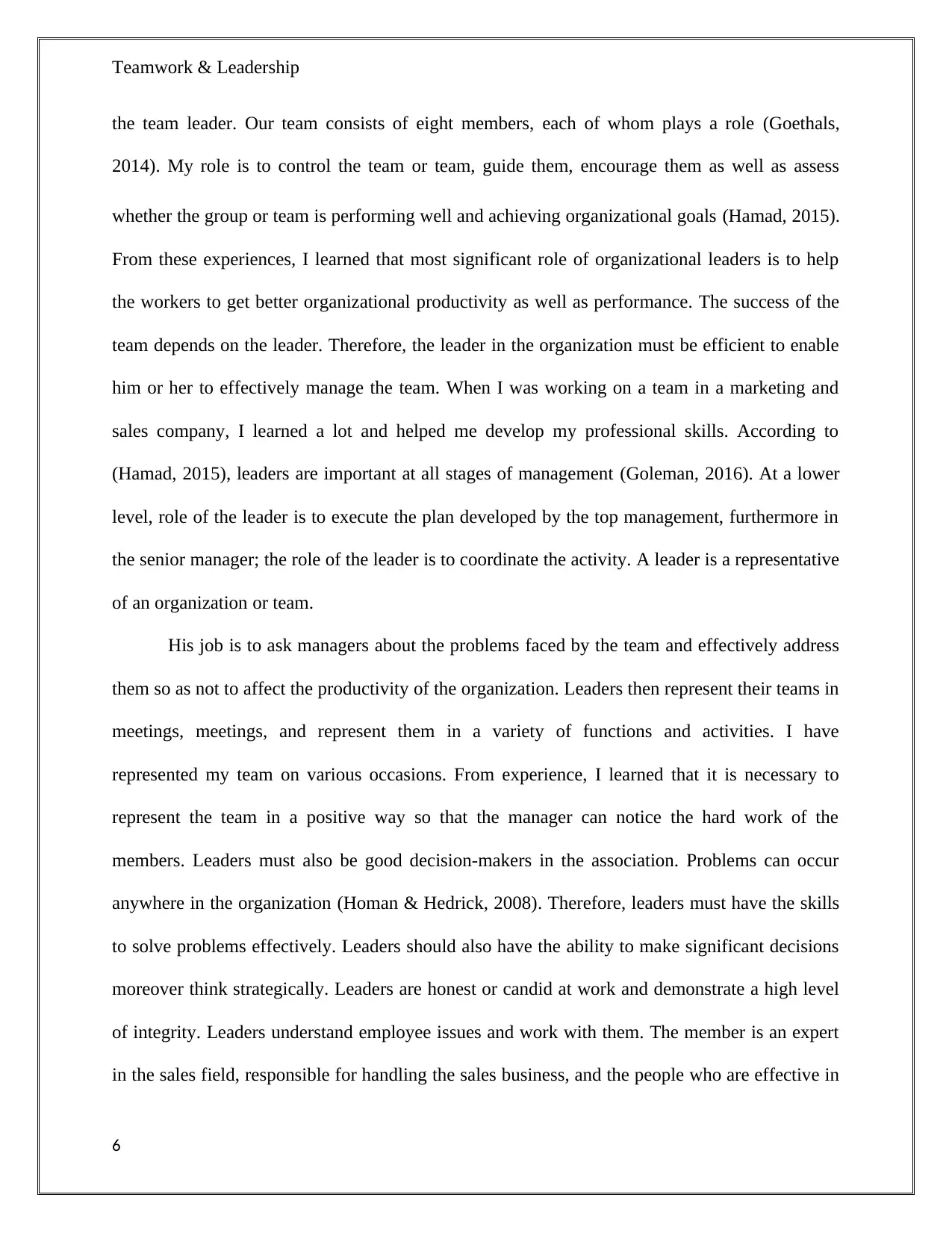
Teamwork & Leadership
the team leader. Our team consists of eight members, each of whom plays a role (Goethals,
2014). My role is to control the team or team, guide them, encourage them as well as assess
whether the group or team is performing well and achieving organizational goals (Hamad, 2015).
From these experiences, I learned that most significant role of organizational leaders is to help
the workers to get better organizational productivity as well as performance. The success of the
team depends on the leader. Therefore, the leader in the organization must be efficient to enable
him or her to effectively manage the team. When I was working on a team in a marketing and
sales company, I learned a lot and helped me develop my professional skills. According to
(Hamad, 2015), leaders are important at all stages of management (Goleman, 2016). At a lower
level, role of the leader is to execute the plan developed by the top management, furthermore in
the senior manager; the role of the leader is to coordinate the activity. A leader is a representative
of an organization or team.
His job is to ask managers about the problems faced by the team and effectively address
them so as not to affect the productivity of the organization. Leaders then represent their teams in
meetings, meetings, and represent them in a variety of functions and activities. I have
represented my team on various occasions. From experience, I learned that it is necessary to
represent the team in a positive way so that the manager can notice the hard work of the
members. Leaders must also be good decision-makers in the association. Problems can occur
anywhere in the organization (Homan & Hedrick, 2008). Therefore, leaders must have the skills
to solve problems effectively. Leaders should also have the ability to make significant decisions
moreover think strategically. Leaders are honest or candid at work and demonstrate a high level
of integrity. Leaders understand employee issues and work with them. The member is an expert
in the sales field, responsible for handling the sales business, and the people who are effective in
6
the team leader. Our team consists of eight members, each of whom plays a role (Goethals,
2014). My role is to control the team or team, guide them, encourage them as well as assess
whether the group or team is performing well and achieving organizational goals (Hamad, 2015).
From these experiences, I learned that most significant role of organizational leaders is to help
the workers to get better organizational productivity as well as performance. The success of the
team depends on the leader. Therefore, the leader in the organization must be efficient to enable
him or her to effectively manage the team. When I was working on a team in a marketing and
sales company, I learned a lot and helped me develop my professional skills. According to
(Hamad, 2015), leaders are important at all stages of management (Goleman, 2016). At a lower
level, role of the leader is to execute the plan developed by the top management, furthermore in
the senior manager; the role of the leader is to coordinate the activity. A leader is a representative
of an organization or team.
His job is to ask managers about the problems faced by the team and effectively address
them so as not to affect the productivity of the organization. Leaders then represent their teams in
meetings, meetings, and represent them in a variety of functions and activities. I have
represented my team on various occasions. From experience, I learned that it is necessary to
represent the team in a positive way so that the manager can notice the hard work of the
members. Leaders must also be good decision-makers in the association. Problems can occur
anywhere in the organization (Homan & Hedrick, 2008). Therefore, leaders must have the skills
to solve problems effectively. Leaders should also have the ability to make significant decisions
moreover think strategically. Leaders are honest or candid at work and demonstrate a high level
of integrity. Leaders understand employee issues and work with them. The member is an expert
in the sales field, responsible for handling the sales business, and the people who are effective in
6
⊘ This is a preview!⊘
Do you want full access?
Subscribe today to unlock all pages.

Trusted by 1+ million students worldwide
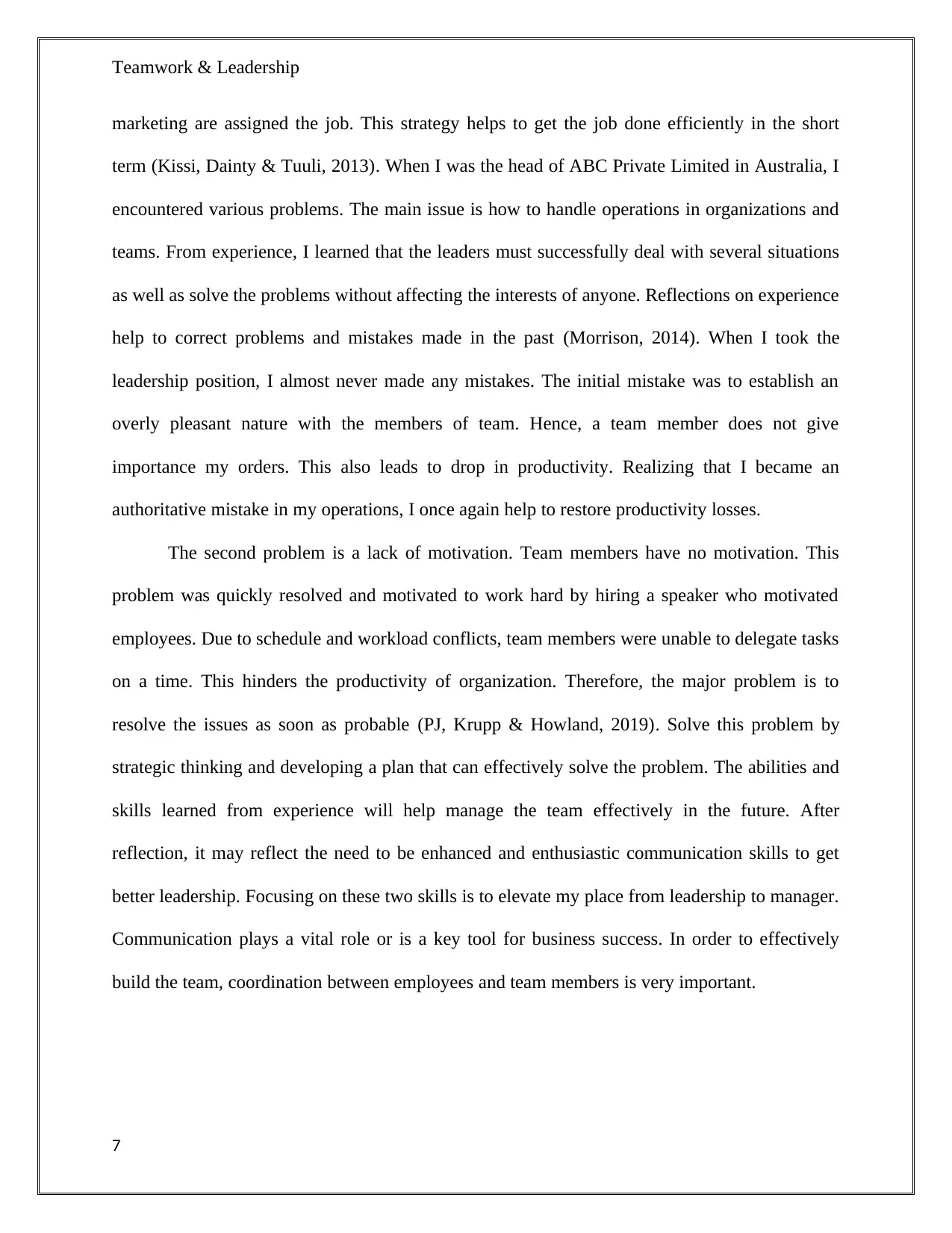
Teamwork & Leadership
marketing are assigned the job. This strategy helps to get the job done efficiently in the short
term (Kissi, Dainty & Tuuli, 2013). When I was the head of ABC Private Limited in Australia, I
encountered various problems. The main issue is how to handle operations in organizations and
teams. From experience, I learned that the leaders must successfully deal with several situations
as well as solve the problems without affecting the interests of anyone. Reflections on experience
help to correct problems and mistakes made in the past (Morrison, 2014). When I took the
leadership position, I almost never made any mistakes. The initial mistake was to establish an
overly pleasant nature with the members of team. Hence, a team member does not give
importance my orders. This also leads to drop in productivity. Realizing that I became an
authoritative mistake in my operations, I once again help to restore productivity losses.
The second problem is a lack of motivation. Team members have no motivation. This
problem was quickly resolved and motivated to work hard by hiring a speaker who motivated
employees. Due to schedule and workload conflicts, team members were unable to delegate tasks
on a time. This hinders the productivity of organization. Therefore, the major problem is to
resolve the issues as soon as probable (PJ, Krupp & Howland, 2019). Solve this problem by
strategic thinking and developing a plan that can effectively solve the problem. The abilities and
skills learned from experience will help manage the team effectively in the future. After
reflection, it may reflect the need to be enhanced and enthusiastic communication skills to get
better leadership. Focusing on these two skills is to elevate my place from leadership to manager.
Communication plays a vital role or is a key tool for business success. In order to effectively
build the team, coordination between employees and team members is very important.
7
marketing are assigned the job. This strategy helps to get the job done efficiently in the short
term (Kissi, Dainty & Tuuli, 2013). When I was the head of ABC Private Limited in Australia, I
encountered various problems. The main issue is how to handle operations in organizations and
teams. From experience, I learned that the leaders must successfully deal with several situations
as well as solve the problems without affecting the interests of anyone. Reflections on experience
help to correct problems and mistakes made in the past (Morrison, 2014). When I took the
leadership position, I almost never made any mistakes. The initial mistake was to establish an
overly pleasant nature with the members of team. Hence, a team member does not give
importance my orders. This also leads to drop in productivity. Realizing that I became an
authoritative mistake in my operations, I once again help to restore productivity losses.
The second problem is a lack of motivation. Team members have no motivation. This
problem was quickly resolved and motivated to work hard by hiring a speaker who motivated
employees. Due to schedule and workload conflicts, team members were unable to delegate tasks
on a time. This hinders the productivity of organization. Therefore, the major problem is to
resolve the issues as soon as probable (PJ, Krupp & Howland, 2019). Solve this problem by
strategic thinking and developing a plan that can effectively solve the problem. The abilities and
skills learned from experience will help manage the team effectively in the future. After
reflection, it may reflect the need to be enhanced and enthusiastic communication skills to get
better leadership. Focusing on these two skills is to elevate my place from leadership to manager.
Communication plays a vital role or is a key tool for business success. In order to effectively
build the team, coordination between employees and team members is very important.
7
Paraphrase This Document
Need a fresh take? Get an instant paraphrase of this document with our AI Paraphraser
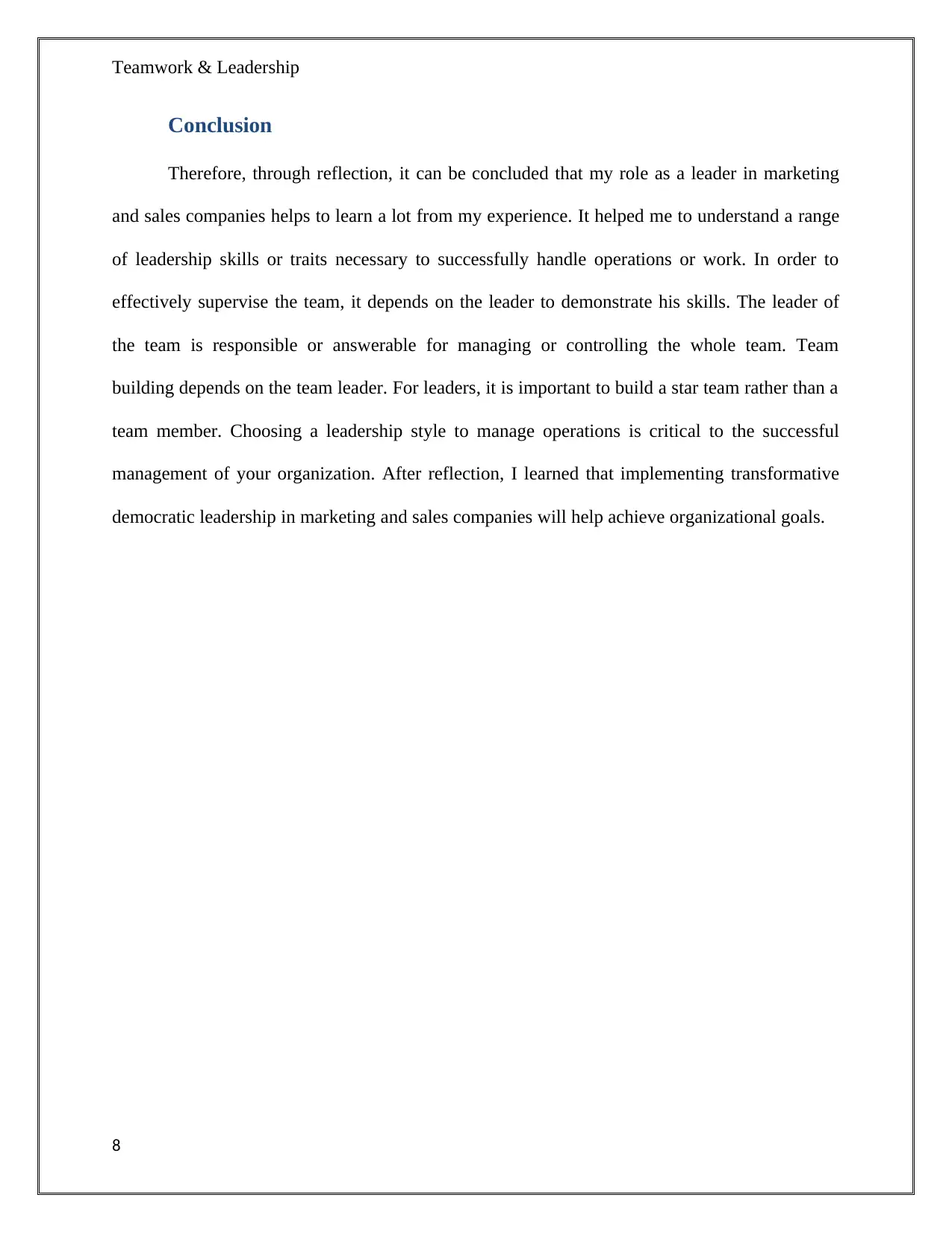
Teamwork & Leadership
Conclusion
Therefore, through reflection, it can be concluded that my role as a leader in marketing
and sales companies helps to learn a lot from my experience. It helped me to understand a range
of leadership skills or traits necessary to successfully handle operations or work. In order to
effectively supervise the team, it depends on the leader to demonstrate his skills. The leader of
the team is responsible or answerable for managing or controlling the whole team. Team
building depends on the team leader. For leaders, it is important to build a star team rather than a
team member. Choosing a leadership style to manage operations is critical to the successful
management of your organization. After reflection, I learned that implementing transformative
democratic leadership in marketing and sales companies will help achieve organizational goals.
8
Conclusion
Therefore, through reflection, it can be concluded that my role as a leader in marketing
and sales companies helps to learn a lot from my experience. It helped me to understand a range
of leadership skills or traits necessary to successfully handle operations or work. In order to
effectively supervise the team, it depends on the leader to demonstrate his skills. The leader of
the team is responsible or answerable for managing or controlling the whole team. Team
building depends on the team leader. For leaders, it is important to build a star team rather than a
team member. Choosing a leadership style to manage operations is critical to the successful
management of your organization. After reflection, I learned that implementing transformative
democratic leadership in marketing and sales companies will help achieve organizational goals.
8
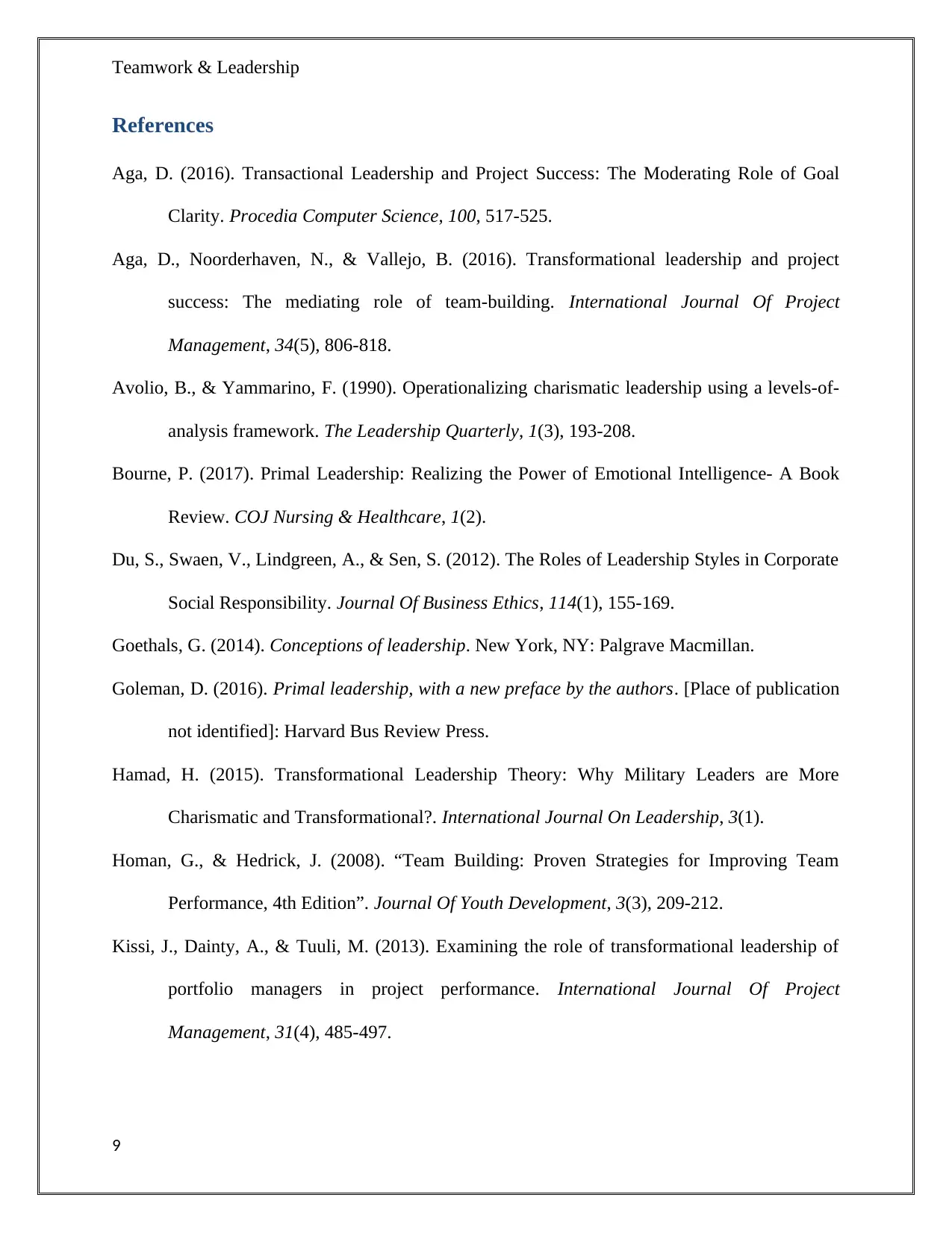
Teamwork & Leadership
References
Aga, D. (2016). Transactional Leadership and Project Success: The Moderating Role of Goal
Clarity. Procedia Computer Science, 100, 517-525.
Aga, D., Noorderhaven, N., & Vallejo, B. (2016). Transformational leadership and project
success: The mediating role of team-building. International Journal Of Project
Management, 34(5), 806-818.
Avolio, B., & Yammarino, F. (1990). Operationalizing charismatic leadership using a levels-of-
analysis framework. The Leadership Quarterly, 1(3), 193-208.
Bourne, P. (2017). Primal Leadership: Realizing the Power of Emotional Intelligence- A Book
Review. COJ Nursing & Healthcare, 1(2).
Du, S., Swaen, V., Lindgreen, A., & Sen, S. (2012). The Roles of Leadership Styles in Corporate
Social Responsibility. Journal Of Business Ethics, 114(1), 155-169.
Goethals, G. (2014). Conceptions of leadership. New York, NY: Palgrave Macmillan.
Goleman, D. (2016). Primal leadership, with a new preface by the authors. [Place of publication
not identified]: Harvard Bus Review Press.
Hamad, H. (2015). Transformational Leadership Theory: Why Military Leaders are More
Charismatic and Transformational?. International Journal On Leadership, 3(1).
Homan, G., & Hedrick, J. (2008). “Team Building: Proven Strategies for Improving Team
Performance, 4th Edition”. Journal Of Youth Development, 3(3), 209-212.
Kissi, J., Dainty, A., & Tuuli, M. (2013). Examining the role of transformational leadership of
portfolio managers in project performance. International Journal Of Project
Management, 31(4), 485-497.
9
References
Aga, D. (2016). Transactional Leadership and Project Success: The Moderating Role of Goal
Clarity. Procedia Computer Science, 100, 517-525.
Aga, D., Noorderhaven, N., & Vallejo, B. (2016). Transformational leadership and project
success: The mediating role of team-building. International Journal Of Project
Management, 34(5), 806-818.
Avolio, B., & Yammarino, F. (1990). Operationalizing charismatic leadership using a levels-of-
analysis framework. The Leadership Quarterly, 1(3), 193-208.
Bourne, P. (2017). Primal Leadership: Realizing the Power of Emotional Intelligence- A Book
Review. COJ Nursing & Healthcare, 1(2).
Du, S., Swaen, V., Lindgreen, A., & Sen, S. (2012). The Roles of Leadership Styles in Corporate
Social Responsibility. Journal Of Business Ethics, 114(1), 155-169.
Goethals, G. (2014). Conceptions of leadership. New York, NY: Palgrave Macmillan.
Goleman, D. (2016). Primal leadership, with a new preface by the authors. [Place of publication
not identified]: Harvard Bus Review Press.
Hamad, H. (2015). Transformational Leadership Theory: Why Military Leaders are More
Charismatic and Transformational?. International Journal On Leadership, 3(1).
Homan, G., & Hedrick, J. (2008). “Team Building: Proven Strategies for Improving Team
Performance, 4th Edition”. Journal Of Youth Development, 3(3), 209-212.
Kissi, J., Dainty, A., & Tuuli, M. (2013). Examining the role of transformational leadership of
portfolio managers in project performance. International Journal Of Project
Management, 31(4), 485-497.
9
⊘ This is a preview!⊘
Do you want full access?
Subscribe today to unlock all pages.

Trusted by 1+ million students worldwide
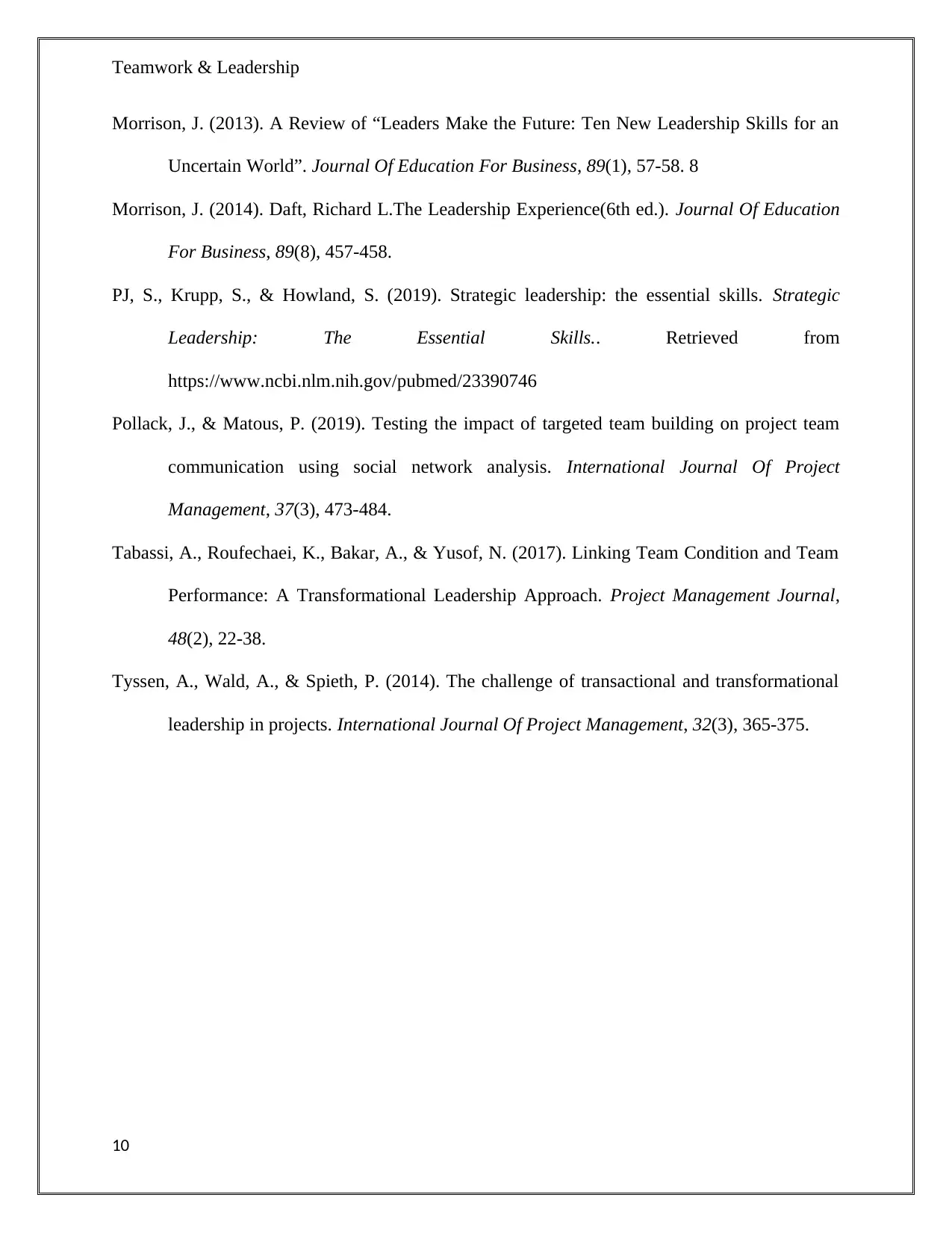
Teamwork & Leadership
Morrison, J. (2013). A Review of “Leaders Make the Future: Ten New Leadership Skills for an
Uncertain World”. Journal Of Education For Business, 89(1), 57-58. 8
Morrison, J. (2014). Daft, Richard L.The Leadership Experience(6th ed.). Journal Of Education
For Business, 89(8), 457-458.
PJ, S., Krupp, S., & Howland, S. (2019). Strategic leadership: the essential skills. Strategic
Leadership: The Essential Skills.. Retrieved from
https://www.ncbi.nlm.nih.gov/pubmed/23390746
Pollack, J., & Matous, P. (2019). Testing the impact of targeted team building on project team
communication using social network analysis. International Journal Of Project
Management, 37(3), 473-484.
Tabassi, A., Roufechaei, K., Bakar, A., & Yusof, N. (2017). Linking Team Condition and Team
Performance: A Transformational Leadership Approach. Project Management Journal,
48(2), 22-38.
Tyssen, A., Wald, A., & Spieth, P. (2014). The challenge of transactional and transformational
leadership in projects. International Journal Of Project Management, 32(3), 365-375.
10
Morrison, J. (2013). A Review of “Leaders Make the Future: Ten New Leadership Skills for an
Uncertain World”. Journal Of Education For Business, 89(1), 57-58. 8
Morrison, J. (2014). Daft, Richard L.The Leadership Experience(6th ed.). Journal Of Education
For Business, 89(8), 457-458.
PJ, S., Krupp, S., & Howland, S. (2019). Strategic leadership: the essential skills. Strategic
Leadership: The Essential Skills.. Retrieved from
https://www.ncbi.nlm.nih.gov/pubmed/23390746
Pollack, J., & Matous, P. (2019). Testing the impact of targeted team building on project team
communication using social network analysis. International Journal Of Project
Management, 37(3), 473-484.
Tabassi, A., Roufechaei, K., Bakar, A., & Yusof, N. (2017). Linking Team Condition and Team
Performance: A Transformational Leadership Approach. Project Management Journal,
48(2), 22-38.
Tyssen, A., Wald, A., & Spieth, P. (2014). The challenge of transactional and transformational
leadership in projects. International Journal Of Project Management, 32(3), 365-375.
10
1 out of 10
Related Documents
Your All-in-One AI-Powered Toolkit for Academic Success.
+13062052269
info@desklib.com
Available 24*7 on WhatsApp / Email
![[object Object]](/_next/static/media/star-bottom.7253800d.svg)
Unlock your academic potential
Copyright © 2020–2025 A2Z Services. All Rights Reserved. Developed and managed by ZUCOL.





